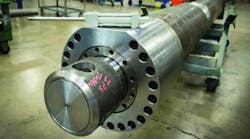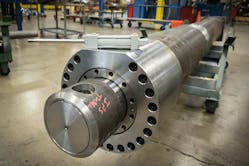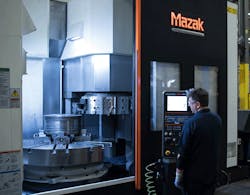This file type includes high resolution graphics and schematics when applicable.
In 2011, Jim Warneke, general manager, and Frank Laratta, manufacturing engineer, both arrived at Hanna Cylinders, Pleasant Prairie, Wis. Their first major project was to give Hanna a much needed “manufacturing face lift,” as they put it, to shorten production lead times. They soon realized stepping up Hanna’s production operations would require totally revamping its entire shop-floor manufacturing workflow. The undertaking would also require bringing in some advanced machine-tool technology to replace several pieces of legacy equipment.
In tandem with the workflow restructuring, lean initiatives, and other changes, the Mazak machine tool technology contributed to a 40% boost in the amount of jobs shipped out by the shop per month. And with the increased production capabilities, the shop can now keep more than 98% of its tie-rod and mobile-type cylinder and quarter-turn actuator production in-house.
Hanna manufactures fluid-power cylinders in standard and custom styles. Cylinder bores can range from 1½ to 60 in., and strokes can run up to 400 in. About 75% of production operations encompass low-volume custom orders, while the remainder is high-volume standard products for OEM customers with orders that can average as many as 700 cylinders per day.
Hanna acquired nine new machine tools from Mazak Corp., Florence, Ky., which allowed them to reduce their total machine count from 50 to 30. The Mazaks provide easy-to-use, common control platforms that shorten setup and part-machining cycle times. They also handle maximum part-turning diameters from 0.5 to 60 in.
“From the start, our biggest manufacturing challenge was our equipment,” said Laratta. “We basically had one of everything and zero flexibility in terms of shifting parts to different machines in the event of downtime for repairs or maintenance. The Mazaks not only helped streamline our equipment lineup, they gave us the ability to switch parts, along with their associated tooling and setups, from one machine to another with minimal effort when needed.”
“In reality, we are now a full-fledged, fast-paced production job shop,” explained Warneke. “Typical lead times are three to five days for standard smaller bore size products and within 10 days for those having bores up to 8-in. diameter. However, additional options and bigger sizes (stroke lengths) can further influence lead times. But, in any event, 90% of the time, we get orders out the door within a week.”
Warneke and Laratta reorganized Hanna’s shop floor for shorter and more streamlined workflow paths. When it comes to any type of stocking, whether raw material or parts, Hanna’s new lean practice is that “what comes in this month, gets used this month.”
“On many of our Mazaks, we shoot for setup times of 10 minutes or less,” said Laratta. “With our old equipment, setups could take hours. In our production environment, we try to follow a 90/10 strategy for setups. This means we set up for what we run 90% of the time and work in the remaining 10% of unscheduled parts. The success of this strategy is highly dependent on the flexibility of our Mazaks. They allow us to quickly react to any unexpected changes with a lot less disruption in the shop.”
To shorten setup times, Hanna uses simple setups and quick-change tooling/workholding wherever possible. They also use standardized workstations and machining cells, each equipped with all of the necessary hand tools and gauges situated within the machinist’s reach.
Hanna’s part-machining cycle times vary based mainly on part size; cycle times average about three minutes for 4-in. bore cylinder components. On the other hand, cycle times for larger-sized cylinder components might run to eight or 10 minutes, or up to 30 minutes for very large parts.
Part modularity, wherever possible, helps keep machining cycle times short at Hanna, as well as its overall job turnaround times. Although finished parts can be different, many of them start out the same. Therefore, the shop will machine parts to certain semi-finished stages, stock them, and finish machining them to specific needs.
“We had 50 or so machines that encompassed every common brand of CNC, so it was basically impossible to have a guy go from one machine to another,” explained Laratta. “But with the Mazaks, we can move people around wherever and whenever needed, and such flexibility is huge for us. At one time, our situation was extremely detrimental. If, for instance, a machinist that ran a particular machine called in sick, that machine sat until he returned because no one else knew the control. With the Mazak controls, we have people that were trained on one of our QTNs, for example, that, if needed, could run the MTN 1600 or one of the vertical machining centers with very little additional instruction.”
“On our older machines, we’d typically scrap two or three pieces trying to get that first good part,” added Laratta. “On the Mazaks, the first piece is a good one, and we can keep programs right in the machine controls.”
This file type includes high resolution graphics and schematics when applicable.




